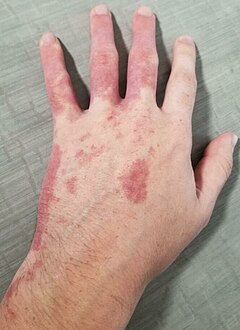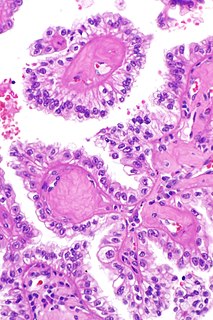Related Research Articles

Nevus is a nonspecific medical term for a visible, circumscribed, chronic lesion of the skin or mucosa. The term originates from nævus, which is Latin for "birthmark"; however, a nevus can be either congenital or acquired. Common terms, including mole, birthmark, and beauty mark, are used to describe nevi, but these terms do not distinguish specific types of nevi from one another.

A port-wine stain is a discoloration of the human skin caused by a vascular anomaly. They are so named for their coloration, which is similar in color to port wine, a fortified red wine from Portugal.

Café au lait spots, or café au lait macules, are flat, hyperpigmented birthmarks. The name café au lait is French for "coffee with milk" and refers to their light-brown color. Café au lait lesions with rough borders may be seen in McCune-Albright syndrome. In contrast, Café au lait lesions of neurofibromatosis have smooth borders.

A dysplastic nevus or atypical mole is a nevus (mole) whose appearance is different from that of common moles. In 1992, the NIH recommended that the term "dysplastic nevus" be avoided in favor of the term "atypical mole". An atypical mole may also be referred to as an atypical melanocytic nevus, atypical nevus, B-K mole, Clark's nevus, dysplastic melanocytic nevus, or nevus with architectural disorder.

Blaschko's lines, also called the lines of Blaschko, are lines of normal cell development in the skin. These lines are invisible under normal conditions, but can become apparent as whorls, patches, streaks or lines in a linear or segmental distribution over the skin due to a mosaic skin condition. They follow a V shape over the back, S-shaped whirls over the chest and sides, and wavy shapes on the head.

Nevoid basal-cell carcinoma syndrome (NBCCS) is an inherited medical condition involving defects within multiple body systems such as the skin, nervous system, eyes, endocrine system, and bones. People with this syndrome are particularly prone to developing a common and usually non-life-threatening form of non-melanoma skin cancer. About 10% of people with the condition do not develop basal-cell carcinomas (BCCs).
Michelin tire baby syndrome, is a condition occurring in babies that is characterized by multiple, symmetric, circular skin creases, or bands, on the forearms, lower legs, and often the neck that are present at birth. The creases disappear later in life. They are reminiscent of those of Bibendum, the mascot of the tire manufacturer Michelin, hence the name of the syndrome. Associated abnormalities vary and may include facial dysmorphism, upslanting palpebral fissures, hypertelorism, cleft palate, genital anomalies, mild developmental delay, ureterocele, smooth muscle hamartoma, nevus lipomatosus, Laron syndrome, and other defects.

Naegeli–Franceschetti–Jadassohn syndrome (NFJS), also known as chromatophore nevus of Naegeli and Naegeli syndrome, is a rare autosomal dominant form of ectodermal dysplasia, characterized by reticular skin pigmentation, diminished function of the sweat glands, the absence of teeth and hyperkeratosis of the palms and soles. One of the most striking features is the absence of fingerprint lines on the fingers.

Transcription factor SOX-10 is a protein that in humans is encoded by the SOX10 gene.

Nevus sebaceus or sebaceous nevus is a congenital, hairless plaque that typically occurs on the face or scalp. Such nevi are classified as epidermal nevi and can be present at birth, or early childhood, and affect males and females of all races equally. The condition is named for an overgrowth of sebaceous glands, a relatively uncommon hamartoma, in the area of the nevus. NSJ is first described by Josef Jadassohn in 1895.
Schimmelpenning syndrome is a neurocutaneous condition characterized by one or more sebaceous nevi, usually appearing on the face or scalp, associated with anomalies of the central nervous system, ocular system, skeletal system, cardiovascular system and genitourinary system.
Phakomatosis pigmentokeratotica is a rare neurocutanous condition characterized by the combination of an organoid sebaceous nevus and speckled lentiginous nevus. It is an unusual variant of epidermal naevus syndrome. It was first described by Happle et al. It is often associated with neurological or skeletal anomalies such as hemiatrophy, dysaesthesia and hyperhidrosis in a segmental pattern, mild mental retardation, seizures, deafness, ptosis and strabismus.

Nevus spilus is a skin lesion that presents as a light brown or tan macule, speckled with smaller, darker macules or papules. Prevalence is around 2%, according to a limited study by Kopf et al.
Oral pigmentation is asymptomatic and does not usually cause any alteration to the texture or thickness of the affected area. The colour can be uniform or speckled and can appear solitary or as multiple lesions. Depending on the site, depth, and quantity of pigment, the appearance can vary considerably.

An acral nevus is a cutaneous condition of the palms, soles, fingers, or toes, characterized by a skin lesion that is usually macular or only slightly elevated, and may display a uniform brown or dark brown color, often with linear striations.

Blue rubber bleb nevus syndrome is a rare disorder that consists mainly of abnormal blood vessels affecting the skin or internal organs – usually the gastrointestinal tract. The disease is characterized by the presence of fluid-filled blisters (blebs) as visible, circumscribed, chronic lesions (nevus).

Nevus depigmentosus is a loss of pigment in the skin which can be easily differentiated from vitiligo. Although age factor has not much involvement in the nevus depigmentosus but in about 19% of the cases these are noted at birth. Their size may however grow in proportion to growth of the body. The distribution is also fairly stable and are nonprogressive hypopigmented patches. The exact cause of nevus depigmentosus is still not clearly understood. A sporadic defect in the embryonic development has been suggested to be a causative factor. It has been described as "localised albinism", though this is incorrect.

Poikiloderma vasculare atrophicans (PVA), is a cutaneous condition characterized by hypo- or hyperpigmentation, telangiectasia and skin atrophy. Other names for the condition include prereticulotic poikiloderma and atrophic parapsoriasis. The condition was first described by pioneer American pediatrician Abraham Jacobi in 1906. PVA causes areas of affected skin to appear speckled red and inflamed, yellowish and/or brown, gray or grayish-black, with scaling and a thinness that may be described as "cigarette paper". On the surface of the skin, these areas may range in size from small patches, to plaques, to neoplasms.

Reed's syndrome is a rare inherited condition characterised by multiple cutaneous leiomyomas and, in women, uterine leiomyomas. It predisposes for renal cell cancer, an association denominated hereditary leiomyomatosis and renal cell cancer, and it is also associated with increased risk of uterine leiomyosarcoma. The syndrome is caused by a mutation in the fumarate hydratase gene, which leads to an accumulation of fumarate. The inheritance pattern is autosomal dominant.
References
- ↑ Rapini, Ronald P.; Bolognia, Jean L.; Jorizzo, Joseph L. (2007). Dermatology: 2-Volume Set. St. Louis: Mosby. p. 853. ISBN 1-4160-2999-0.
- ↑ Marchesi L, Naldi L, Di Landro A, Cavalieri d'Oro L, Brevi A, Cainelli T (August 1992). "Segmental lentiginosis with "jentigo" histologic pattern". Am J Dermatopathol. 14 (4): 323–7. doi:10.1097/00000372-199208000-00007. PMID 1503204.
- ↑ Simoes GA (February 1981). "Speckled zosteriform lentiginous nevus". J. Am. Acad. Dermatol. 4 (2): 236–8. doi:10.1016/S0190-9622(81)80245-9. PMID 7217395.
- ↑ "Speckled Lentiginous Nevus".